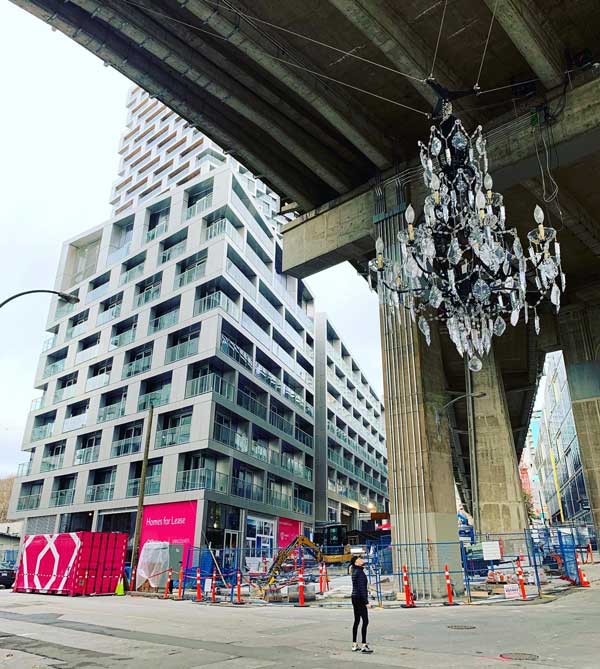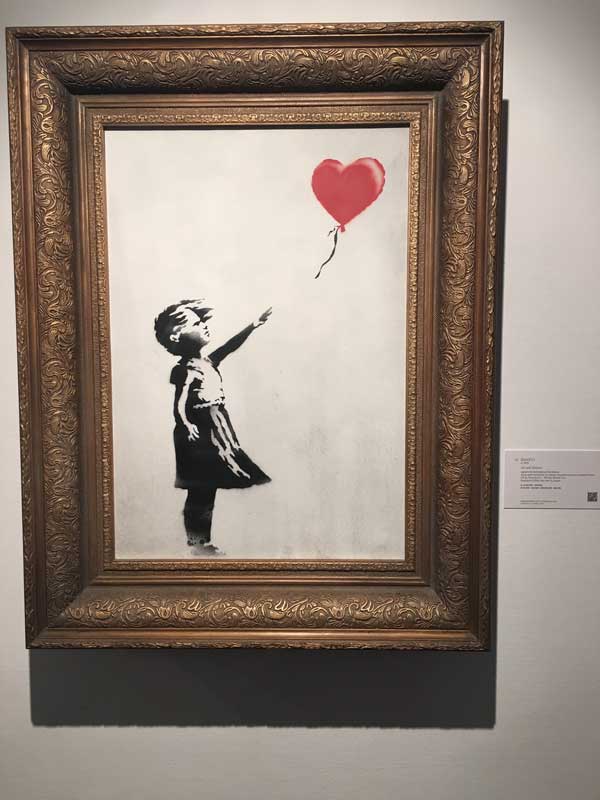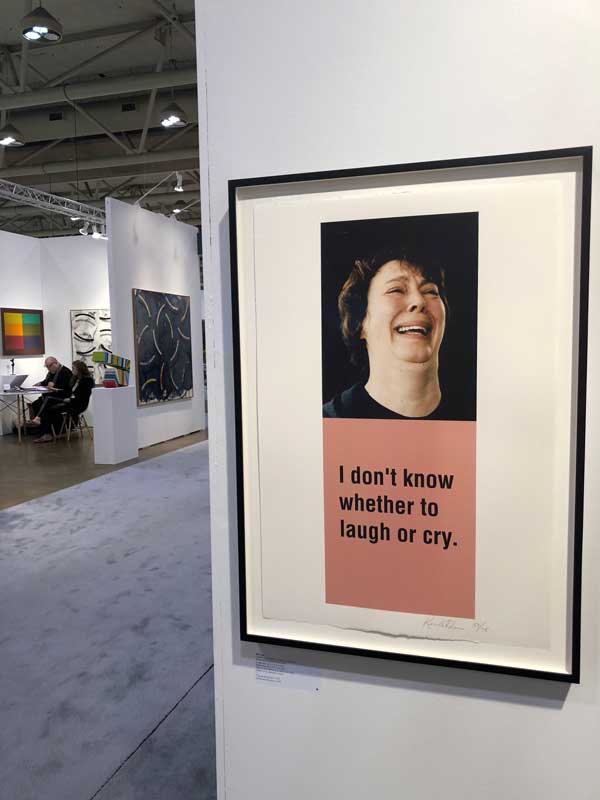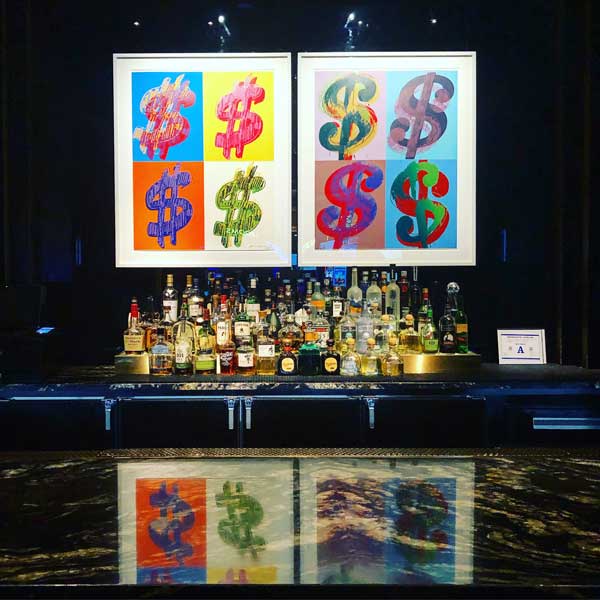D.1 The Price of Everything: Commerce, Aesthetics and the "Value" of Contemporary Art
Fri Oct 16 / 11:00 – 12:30
voice_chat expiredchairs /
- Dorothy Barenscott, Kwantlen Polytechnic
- Lara Tomaszewska, Openwork Art Advisory

Rodney Graham’s Spinning Chandelier (2019), public art in Vancouver, 2019. Photo: Dorothy Barenscott.

Banksy, Girl With Balloon (2006) in gold frame at Sotheby’s preview, 2018. Photo: Lara Tomaszewska.

Ken Lum, limited edition print at Toronto Art Fair, 2018. Photo: Dorothy Barenscott.

Andy Warhol, Dollar Sign (Quad) (1982) in bar lounge at Palms Hotel, Las Vegas. Photo: Dorothy Barenscott.
In recent years, the conversation around contemporary art, and how it is “valued,” has been set against the backdrop of public scandal and spectacle. Media coverage of record prices attained at art auctions, the global expansion of branded art fairs, and protests surrounding museum trustees and donors connected to conflicting interests, co-mingle with viral art world news stories that spark great public debate, such as the shredded Banksy performance at Sotheby’s London in 2018; the Maurizio Cattelan banana piece and aftermath at Art Basel last year; or closer to home, the controversies surrounding Rodney Graham’s public art work Spinning Chandelier funded by a luxury condo developer in Vancouver. This panel seeks to examine the broader and critical dimensions of this issue and calls for presentations that explore, whether through specific case study or theory-based examination, the contours and stakes around how contemporary art is “valued,” collected, and given meaning in the current climate.
Dorothy Barenscott is an art historian whose research relates to the interplay between urban space and emerging technology and media forms in the articulation of a range of identities. She completed her Ph.D. in Art History, Visual Art, and Theory at the University of British Columbia, and currently teaches modern and contemporary art history and theory in Kwantlen Polytechnic University’s Fine Arts Department. Barenscott is co-editor of the book Canadian Culinary Imaginations (McGill-Queen’s University Press, 2020), an interdisciplinary collection that explores how Canadian writers, artists, academics, cooks, performers, and gallery curators are inspired and challenged by the topic of food, and her essays have appeared in journals such as Postmodern Culture Journal, Invisible Culture, History and Memory and Mediascape. Outside of her academic research, Barenscott leads interdisciplinary student groups on field schools to global art cities, and maintains a public blog, Avant-Guardian Musings, dedicated to visual culture research and pedagogy.
Lara Tomaszewska (PhD in Art History, Visual Art, and Theory, UBC, 2007) is an art historian, fine art appraiser, and art advisor to private and public collections in North America, the UK, and Europe. She is Founder and Principal of Openwork Art Advisory, an independent art management firm that specialises in provenance and exhibition research, appraisals, and private sales and acquisitions. Lara has led collection management projects and exhibition planning for both private and public organisations, including collaborations with the Henri Matisse Archives in Paris and the Barber Institute of Fine Arts at the University of Birmingham. Lara has led transactions on works by a broad range of modern and contemporary artists, including but not limited to: Henri Matisse, Edvard Munch, Pierre Auguste Renoir, Pablo Picasso, Andy Warhol, Dale Chihuly, Jeff Koons, Jean Paul Riopelle, and Gordon Smith.
D.1.1 Measure of Worthiness: The Values of Contemporary Art
Marie Leduc, Independent Scholar
Exhibitions, awards, and publications are some of the ways in which contemporary art is celebrated and publicly acknowledged. These activities tell us which objects and artists are to be appreciated and valued in the context of contemporary art. Each of these art-world activities – whether a museum exhibition, biennale, art fair, commercial gallery show, or art award – is also accompanied and supported by multiple discourses that introduce an artist and her work and explain their worthiness or value. The question that this paper explores is, what types of values serve as the measures of worth for contemporary art?
Theoretically the paper draws on Luc Boltanski and Laurent Thévenot’s studies of justification, Nathalie Heinich’s research on the valorization of modern and contemporary art, Michèle Lamont’s sociology of values, and my own research on the reception and valorization of contemporary art. From these I propose that our “cognitive frame” for art is shaped by values or measures of worthiness that guide us in our understanding of what is and is not contemporary art. To test this thesis, I examine five English texts – curatorial essays, reviews, and a feature article from 2015-2017 – written about the work of acclaimed performance artist, Anne Imhof. The analysis considers how each author supports the valorization of Imhof’s work by demonstrating its significance, originality, and authenticity. The analysis reveals how these three primary values are also supported by other aesthetic, social, and political values which, while not universal or enduring, indicate some of the key measures of worthiness that define contemporary art today.
Marie Leduc is an independent scholar and art historian living in Canada. She holds an MA in Art History from York University, Toronto and an interdisciplinary (sociology and art history) PhD in Visual Art and Globalization from the University of Alberta, Edmonton. Her interdisciplinary research combines art history and the sociology of values to explore the recognition and valorisation of contemporary art. She is the author of Dissidence: The Rise of Chinese Contemporary Art in the West (MIT Press, 2018), and articles, reviews, and interviews published in Canadian Art, Yishu: Journal of Contemporary Chinese Art, Media-N: The Journal of the New Media Caucus, and Journal of Visual Art Practice.
D.1.2 The Pure Taste Indicator: A new reference model for the Art World
David Hinojosa Admann, Organization for the Democratization of Visual Arts
Studies, testimonies, open letters to museums, indicate that the current art world is undemocratic and unequal when it comes not only to museums and art galleries, but also art press, research and the art market. Recent events from Covid pandemic to black lives matter amplified the centralization of power in the hands of a few players, racial discrimination, gender bias, corruption, traffic of influence, all of which hold back museums from being inclusive equitable organizations and hinder the growth of the art world. This paper sheds light on the current challenges in the art word and reflects on the possibility of a new way to measure the value of art through the Pure Taste Indicator (PTI). The PTI is a new reference model for the art world, created by the Organization for the Democratization of Visual Arts (ODBK) in response to the current state of the art sector. This reference model is based on participatory economics, demarchy and referendums, allowing it to represent the taste and knowledge of a bigger number of art world participants composed of artists, art world professionals and art lovers. By dismantling the hierarchical power structures that characterized art for so long, the PTI mechanism can change how the art ecosystem functions and help the art world minimize inequality. This grass root initiative aims to help art institutions respond to the demand to be more inclusive, to support women artists and artists of color, and implicate a larger number of individuals in decisions pertaining to contemporary art. The PTI proposed by ODBK lets art transcend its monetary value, so that its value resides in its quality which is defined by all art world participants.
Originally from Mexico, David Hinojosa Admann lives and works between Berlin and Madrid. He is a mixed and new media artist and the founder of ODBK (Organization for the Democratization of the Visual Arts). With a background in computer science and marketing, Admann obtained his MFA in Madrid in 2003, and has since exhibited extensively throughout Europe and Central America. His practice ranges from more traditional media like drawing and painting, to multidisciplinary, media and artistic research. His projects address the relationship between conceptual art, commerce and democratization of the contemporary art world. Admann’s work takes a critical, and sometimes humorous, approach to the circumstantial phenomena of the art market.



